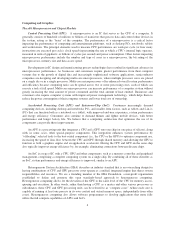AMD 2014 Annual Report Download - page 18
Download and view the complete annual report
Please find page 18 of the 2014 AMD annual report below. You can navigate through the pages in the report by either clicking on the pages listed below, or by using the keyword search tool below to find specific information within the annual report.has been able to control x86 microprocessor and computer system standards and benchmarks and to dictate the
type of products the microprocessor market requires of us. Intel also dominates the computer system platform,
which includes core logic chipsets, graphics chips, motherboards and other components necessary to assemble a
computer system. OEMs that purchase microprocessors for computer systems are highly dependent on Intel, less
innovative on their own and, to a large extent, are distributors of Intel technology. Additionally, Intel is able to
drive de facto standards and specifications for x86 microprocessors that could cause us and other companies to
have delayed access to such standards.
Intel has substantially greater financial resources than we do and accordingly spends substantially greater
amounts on marketing and research and development than we do. We expect Intel to maintain its market position
and to continue to invest heavily in marketing, research and development, new manufacturing facilities and other
technology companies. To the extent Intel manufactures a significantly larger portion of its microprocessor
products using more advanced process technologies, or introduces competitive new products into the market
before we do, we may be more vulnerable to Intel’s aggressive marketing and pricing strategies for
microprocessor products. For example, Intel recently introduced microprocessors for low-cost notebooks, similar
to products that we offer for low-cost notebooks.
Intel’s position in the microprocessor market and IGP chipset market, its introduction of competitive new
products, its existing relationships with top-tier OEMs and its aggressive marketing and pricing strategies could
result in lower unit sales and a lower average selling price for our products, which could have a material adverse
effect on us.
Other competitors include a variety of companies providing or developing ARM-based designs at relatively
low cost and low power processors for the computing market including netbooks, tablets and thin-client form
factors, as well as dense servers, set-top boxes and gaming consoles. ARM Holdings designs and licenses its
ARM architecture to third parties, including us, and offers supporting software and services. Our ability to
compete with companies who use ARM-based solutions depends on our ability to timely design and bring to
market energy-efficient, high-performing products at an attractive price point.
In the chipset market, our competitors include suppliers of IGP chipsets. PC manufacturers use IGP chipsets
because they cost less than traditional discrete GPUs while offering acceptable graphics performance for most
mainstream PC users. Intel also leverages its dominance in the microprocessor market to sell its IGP chipsets.
Intel manufactures and sells IGP chipsets bundled with their microprocessors and is our main competitor in this
market.
Competition in the Graphics Markets
In the graphics market, our competitors include suppliers of discrete graphics, embedded graphics
processors and IGP chipsets. Intel manufactures and sells embedded graphics processors and IGP chipsets, and is
a dominant competitor with respect to this portion of our business. Higher unit shipments of our APUs and
Intel’s integrated graphics may drive computer manufacturers to reduce the number of systems they build paired
with discrete graphics components, particularly for notebooks, because they may offer satisfactory graphics
performance for most mainstream PC users, at a lower cost. Intel could take actions that place our discrete GPUs
and IGP chipsets at a competitive disadvantage such as giving one or more of our competitors in the graphics
market, such as Nvidia Corporation, preferential access to its proprietary graphics interface or other useful
information.
Our principal competitor in the graphics market is Nvidia. AMD and Nvidia are the two principal players
offering discrete graphics solutions. Other competitors include a number of smaller companies, which may have
greater flexibility to address specific market needs, but less financial resources to do so, especially as we believe
that the growing complexity of graphics processors and the associated research and development costs represent
an increasingly higher barrier to entry in this market. In the semi-custom game console products, where graphics
performance is critical, we compete against primarily Nvidia, and also compete against Imagination Technology
Group.
12
























